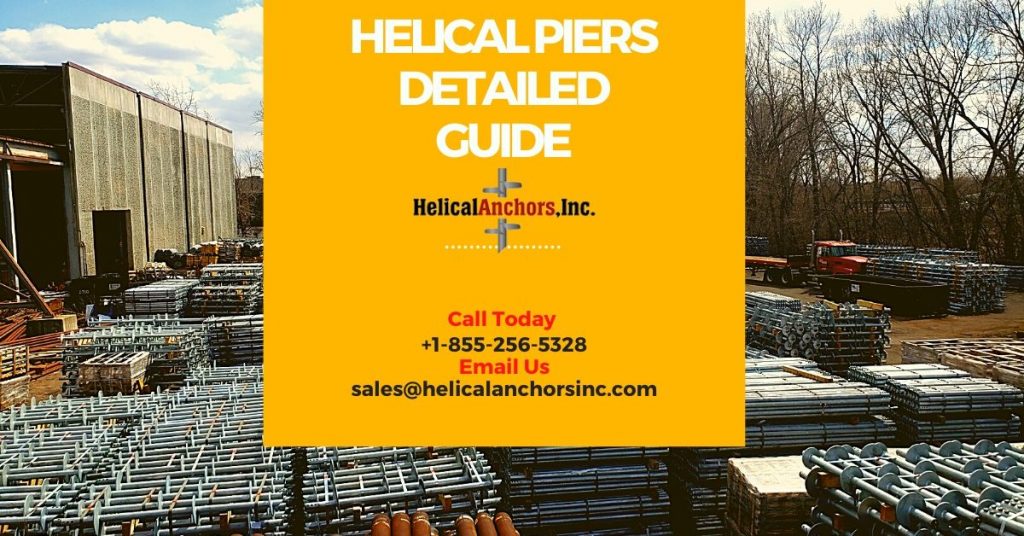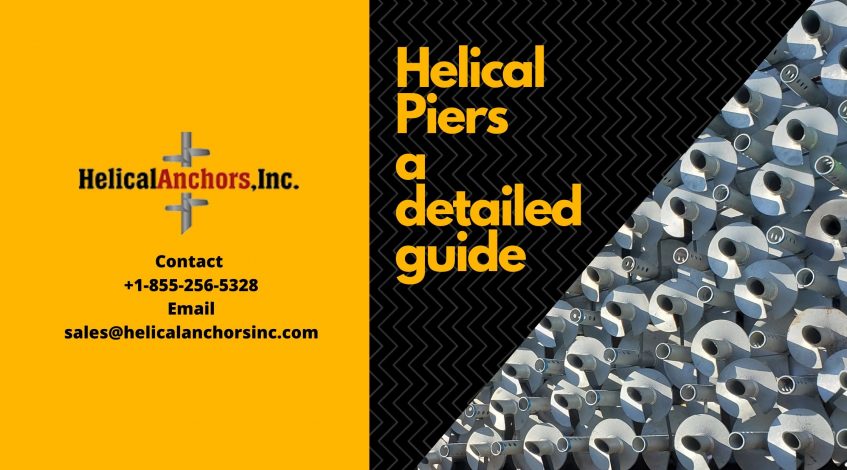Helical Piers is also known as a helical pile, helical anchor and at times call screw piers and often used interchangeably. This is a detailed guide on Helical Piers
Almost 43.4% of the structures lose their strength within a few years of their construction. We can help you in protecting your structure from all adverse situations and damages.
Want to know how big structures stand tall and maintain their strength? Please read the below article to know how we can strengthen your structure’s foundation with the help of our Helical Piers.
Read Below the Helical Piers Detailed Guide
What Are Helical Piers?
Helical Piers are the anchoring systems used for building deep foundations and strengthening the foundation of the structure and made from tubular hollow sections. It is necessary to install helical piers if you want to protect the foundation of your structure. Helical piers used for both commercial as well as residential purposes. Helical piers are durable in nature, and their installation is quick. Moreover, helical piers are also cost-effective.
WHAT DO HELICAL PIERS DO?
Helical Piers are used to providing foundation support to the structures of all shapes and sizes. Helical Piers are installed deep beneath the earth’s surface to support the buildings and structures which stand atop them. Many times there are several piers installed to provide support for a building, bridge, or tower.
HOW ARE HELICAL PIERS MADE?
Helical Piers manufactured using galvanized steel to protect it from rusting. Generally, they are round hollow shafts or square shafts prepared from steel. They are available in various shapes and diameters as per the requirement of the project. During their fabrication, one or more steel screw threads are welded onto the shaft to enable sufficient downward force into the earth’s surface and drill into the surface. The plane kept as per the standards, but the shapes and sizes may vary as per the application. Helical piers are long-lasting with a life expectancy of almost more than 100 years, depending upon their usage and load employed.
HOW DO HELICAL PIERS WORK?
Helical Piers installed by drilling them deep into the surface. With each shaft of the pile being drill down, an additional segment is coupled into the bolted coupler every single time, resulting in an only helical pier with the ability to extend hundreds of feet deep below the surface of the earth. Typically helical piers are themselves capable of providing support to the structure. However, in some cases, the concrete foundation is also incorporated with them to enhance the strength of the foundation further.
When to use Helical Piers
Helical Piers used in residential as well as commercial applications. They are used to support and strengthen the foundation of the structure. They are also used to repair the damaged foundation. Helical Piers are also instrumental in the adverse soil conditions where conventional foundation systems fail to perform. Below are the
circumstances in which helical Piers can prove to be extremely useful.
● To repair the cracks and splits on the interior walls.
● The repair an uneven floor
● To remove the large gap formed in the door and window frames
● To remove the hindrance produced while closing and opening the doors.
● To repair the cracks and splits formed in basement walls.
The most significant advantage of employing helical Piers for repair works is that they take less time and disturb daily operations for a short duration.
Advantages of using Helical Piers
There are numerous advantages offered by helical Piers over conventional foundation system:
No Excavation
Helical piers don’t require excavation for its installation, reducing the overall time and cost of the project. Since it does not require digging, it also produces minimal waste and disturbance to the surrounding area. It keeps the site clean, and therefore the time needed for clean up is also saved.
Quick Installation
The most significant advantage of using a helical pier is that it can be loaded immediately. Unlike conventional concrete piles, it doesn’t require time to settle down. Also, it does not require any additional machinery, such as a crane or large drilling equipment for its installation. It’s loading capabilities can be increased by coupling it with small equipment.
Small Footprint and minimum Vibration
Helical piles produce minimum noise during their installation; therefore, easily used in the restricted areas. It creates the least disturbance in the nearby surroundings.
No time to Settle down
The best thing about the helical Piers is that they can be loaded immediately after their installation. Unlike conventional concrete foundation systems, they don’t need time to settle down. Their loading capacity increases with time. The older they become, the better will be their loading capacity.
Environmentally Friendly
Helical Piers are environment friendly also. They produce minimal disturbance to the surrounding. Generally, the manufacturer employs high quality recycled steel for its fabrication process, makes the fabrication process environment friendly, and reduces the overall carbon footprint.
Installation carried out throughout the year.
Unlike conventional concrete foundation systems, Helical Piers don’t need time to settle down or dry; therefore, installed in any season throughout the year. Whether it is winter, summer, or rainy season, they can be installed easily in any season.
It is installed on any soil condition and remote areas.
Helical Piers are best suited for projects located in remote areas. Since they don’t require large machinery and equipment for their installation, they can be easily used in the regions where mobilization costs tend to be high, and other construction support services are limited and not readily available.


